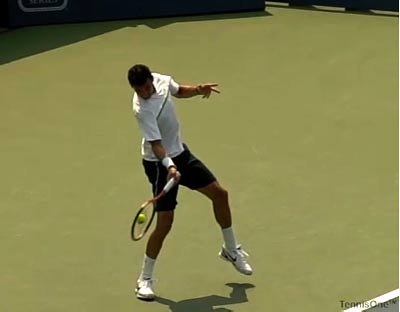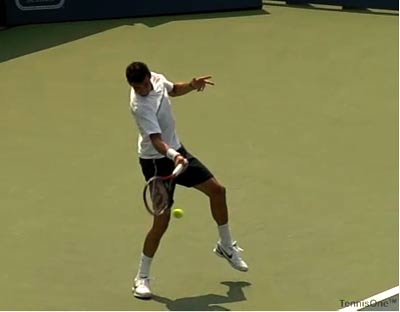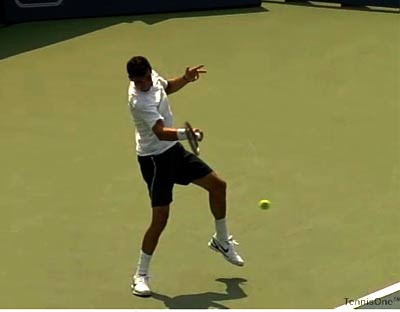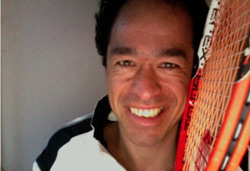|
TennisOne Lessons Timing: The Right Unbalance Jerôme Inen Ever hit the ‘Super-on-Out’-return? Sure you have. It goes like this: your opponent hits a serve that is at least three feet long. You call 'out' and hit the ball back... and you hit it back so fast, so sweet, so well timed you are amazed. It is actually quite confrontational. ‘Why can't I do that all the time?’ ‘Why can't I do it with a serve that is IN (after all, it’s a few feet shorter and we have more time to hit it)?' Generally this phenomenon is explained by saying that it’s a matter of ‘relaxation' or, the stale 'it’s all mental’ explanation. But ask yourself: where do club tennis players hit the ball, when they make a mistake? That’s easy: they hit the ball in the net (as opposed to Pros who rarely err into the net). Often players will say (or shout): ‘I was too late’. But I beg to differ. I think that most players who struggle with their timing — on one shot or in their game in general — are not habitually late at all. They try to hit the ball too early… And I also think that a lot of players try to be too much in balance when they hit… which again negatively affects their timing. In this article I want to explain the interaction between timing and what I call ‘the right unbalance’. For this, I have the good fortune to be inspired by other regular contributors of TennisOne: Jim McLennan, Doug King, and Jack Broudy. Let’s start with a simple exercise. Stand up straight, with your legs apart, a little bit wider than shoulder width. Relax your knees a little bit, so you are standing in a position you could hold for a long time (not that you have to for this exercise, trust me!). Put your hands together, with the palms relaxed (not pressed) against each other. This is really important: be as loose as you can be during this! Not slowly start bringing your weight to your left foot. And I mean slowly. Then continue shifting your weight, until you are balanced on your left foot fully, and your right foot is just able to touch the floor, suspending you, as it were, in flight. Most probably, you’ve let nature take its course and moved both your arms to the left with your weight.
Watch and feel your shoulder, arm, and hands, how they are positioned. You probably notice that the palm of your left hand has turned slightly upward, your right hand has turned palm down, and there even is a slight but noticeable separation of the hands starting to appear. Now start shifting your weight the other way, repeating the first movement, only in the other direction. Don’t try to steer anything, just witness and feel what your body is doing. Perhaps you will now feel, as it happens, how your shoulders, arms and hands start to tilt towards ever so slightly over and to the ground. Every reader who has once read or thought about ‘racket head’-control will by now be alert. The moment a ball hits a racket, the trajectory of the ball is determined. If the strings point up at impact, the ball will go up. If the strings point down, the ball will fly into the ground. If the strings point straight ahead, the ball will fly straight… but out. If you have studied slow-motion imagery of, say, a top player hitting a topspin-groundstroke, you will have noticed that the racket head is ever so slightly tilted forward… on a slice, the racket head is ever so slightly tilted backward. Now let’s go back to the moment on court when you shouted: ‘I was late!’ It stands to reason that when someone is ‘late’, he or she has hit the ball PAST the ideal contact point, that is, further back in the stance. Which means the racket was not far AHEAD enough. So, with a topspin-forehand, with a swing from low to high, this would mean that the ball has been hit with the strings pointing too much UP instead of forward. Take these photos of Grigor Dimitrov hitting a topspin forehand. The racquethead goes toward the ball almost vertical... but it's slightly tilted forward by the natural movement of the hips, shoulders and forearm
At contact the racquethead is tilted vertically for real, by the rebound of the ball against the strings. After contact the racquethead is tilted backward, that is to say: to a more vertical position. Then the racquethead goes on along the flight path of the ball, in the same vertical position, until a certain moment, when the player starts to pull the racquet past his chest. When someone is too early (or hits the ball too far out in front), the racquethead will be not be tilted backwards by the contact, because the arm and wrist are pronated so much (on the forehand) that it won't be 'pushed' to the vertical position. That's why most mistakes end up in the net (except for the fact that most players hit too flat and too low of course by intent). If you hit a slice backhand (or forehand) and you hit the ball too early, meaning, too much in front of you, the strings of the racket will point up too much and the ball will sail long. The racket path would be from high to low, opening up just a wee bit just before contact... when you are too early, the shoulder will already have rotated inward (wrist pronates, thumb rotates back and to the ground, towards body) and the racquet face that contacts the ball will tilt upwards. Hence: when we shout ‘Too late!’ the ball should fly left, right and/or out…but most of the time, when we err under pressure or just because we were lazy, we hit the ball into the net. Which means at the point of impact the strings were pointing too much down… which means we hit the ball to far out in front, hence too early! My idea is this: competitive tennis players are a thorough but nervous lot. They have a ‘you can never be too early’-attitude. So, on court, they prepare as early as they can for the oncoming ball. And often they try to hit the ball when it can be hit… and I think most of the players try hit the ball when it’s not really close enough to the body. So how can we find that elusive timing of the ‘Super-on-Out-return’, a hit that is neither too early nor too late? The right angle of the strings against the ball is incredibly subtle. The ball only ‘lies’ against the strings one 5th of a second… No wonder that if you consciously try to manipulate the angle of the racket it will always feel clumsy and mechanical. The trick is to make your body the conductor of this timing. You have to let your body make a very normal, natural movement… and, as if by chance, drop a ball into that movement, a welcome intruder. The ball has to become a part of the movement you are going to make. Before I give you some exercises, let me give you an analogy to get the philosophical part of this idea across. Imagine riding a bike. On your bike, your legs and feet push the pedals down and round. With that movement you turn around an axis with cogs on which a chain runs. The cogs ‘bite’ into the holes of the chain and then let go again. The chain moves the rear wheel. Hallelujah, you are moving! While riding your bike, you don’t have to think about the cogs that grab the chain. You make a fluent motion with your feet and legs, the chain doesn’t stop and start, if flows forth, it turns. You don’t have to command your feet or the chain. The Waiting is the Thing In tennis, it’s important to combine ‘feeling’ with ‘watching’. With that, I mean watching the ball from the inside out, not the other way around. (See my article ‘Don’t lose your focus’ on TennisOne for a more thorough explanation about watching in tennis). The lesson we’ve learned from the ‘Super-on-out-Return’ is that often when we think we are past the ‘ideal moment’ of the ball, we accidentally time the ball right on the spot. The point of the matter is that the right timing of the tennis ball has a ‘waiting quality’. Usually, we strive to be ready for the ball, which means we have time to spare to hit the ball. Which means… waiting. But how should we wait for the ball? With our racket back and the weight on our back foot? I don’t think that is wise. Because then we wait in balance for the ball. Better would be to wait in a neutral, noncommittal position for the ball, until it has bounced and until it really starts arcing into your body-zone. (For a good article about the last moments before the hit please read Doug King's, Deconstructing the Unit Turn.) The Right Unbalance. Several other contributors to this site have written or talked about this ‘waiting’ aspect of the game. Jim McLennan talks here about ‘Waiting on the ball’, Doug King wrote about ‘waiting for the hit’ in his recent series. To their fine observations, I want to add another dimension: using the right unbalance.
‘Unbalance’ seems something we humans try to avoid, on the court and in daily life, but being in unbalance is the essence of moving. Walking, for example, is nothing more than making us fall forward… and then stopping the catastrophe by putting the foot forward and on the ground. But there is a subtle extra there worth knowing. Watch the footage of the woman walking. Pay special attention to the moment just before the front foot is put down. The footage is in slow motion, but even then you can see there is a slight pause, a hesitation just before the step is made. That slight pause is what makes walking fluent and well timed. Now here, finally, we are coming to the crux of this article. Timing the tennis stroke in a fluent way is a combination of two elements:
Jack Broudy has written several excellent articles about this ideal hitting spot (see here for just a start). He has also explained some exercises I am going to refer to, but first I have a very simple one for you, for which you need the help of a friend or coach. Stand ready, with your face hands and toes pointing forward. Now ask your helper to throw a ball to you — from the side. You can choose to use an open stance forehand or a more semi-open stance I am using here. Start turning in only at the moment the ball is thrown to you. Also, it’s important to see the ball at the 45 degree angle of your bellybutton and to feel how the ball seems to ‘fall’ into a slot. Because of the dynamic imbalance thus produced, it will take you surprising little effort to give speed and direction to the ball. Repeat several times!
A warm-up routine of Jack Broudy that has helped my timing a lot (and that of a lot of my students) is this combo:
The exercises in this article and in the articles I referred to, will help you to use your body for your timing. Believe me, your body is a fantastic expert in finding the right timing for natural, easy movement… you just have to help it to combine with that darned little rascal called the ball. Your comments are welcome. Let us know what you think about Jerôme Inen's article by emailing us here at TennisOne.
"I’ve learned tennis the traditional, form-oriented way — and it is not the right way! Lijftennis is my attempt to show other people a way to learn quicker, with better results and less frustration. If I have one message: don’t copy others, play and learn from your own body and perspective!" |



 Jerôme Inen of
Jerôme Inen of